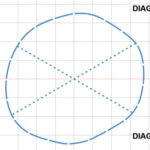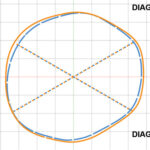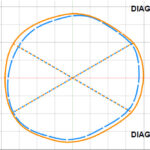When Milo’s mom, Olivia, first raised concerns about her 7-month-old’s head shape, his pediatrician referred her to a local orthotist for a cranial remolding orthosis. After hearing about traditional and 3D printed options, Olivia felt confident in choosing Surestep’s new Sprout3DTM helmet due to its lightweight structure, single-sided hinge opening (making it easier for busy parents to open with only one hand), the perforated foam for better ventilation, and a plagiocephaly-specific trim line.
Summary
After being measured by his clinician, Milo’s helmet was fabricated with top-of-the-line 3D printing technology, allowing for a quick turnaround time and a precise fit – resulting in minimal modifications.
Milo’s helmet journey was a breeze for both Milo and mom, with Olivia saying, “When I took my son to his pediatrician, she couldn’t believe how easy it was to take the helmet on and off. The unique snap-on feature was probably the most raved about in my circle of friends and family.”
Throughout the helmet journey, Milo went through a couple growth spurts and received quick adjustments with minimal modifications – providing ease and comfort for both Milo and mom. Thanks to Sprout3D’s breathable features, Milo stayed cool despite his hot nature, and Olivia was able to easily clean the helmet.
Results
With his measurements moving from moderate severity to the normal range, Milo successfully “graduated” with flying colors after only two short months! Olivia states, “I would recommend Sprout3D to anyone who is considering a helmet for their child. I truly could not have asked for a better experience for my son.”
November 7, 2024

December 16, 2024

January 6, 2025

The Surestep Sprout3D™ Cranial Remolding Orthosis (CRO) is transforming cranial care with a cutting-edge 3D design that delivers precision, comfort, and efficiency. Developed by leading cranial specialists, Sprout3D leverages over 10,000 data points, decades of expertise, and extensive 3D fabrication resources to ensure the best possible patient outcomes.
Learn how to care for your child’s new Sprout3D CRO.
Do you have a sweet baby with cranial asymmetry, such as plagiocephaly or brachycephaly? There’s a simple way to help your baby’s head shape!
Sprout3D™ is Surestep’s new cranial remolding orthosis that changes head shapes fast, and it’ll keep your baby comfortable the whole time.
What is a cranial remolding orthosis (cranial helmet), and how does it work?
What is a cranial remolding orthosis (cranial helmet), and how does it work?
CRO stands for “cranial remolding orthosis” and is more commonly called a cranial helmet. It’s an orthotic device that:
- Gives a gentle barrier to growth on some areas of the head, slowing growth there
- Gives space on other areas of the head for more growth
The inner surface of the helmet passively guides skull growth while keeping your baby comfortable. National cranial specialists developed Sprout3D by combining 10,000 data points and decades of clinical experience, leading to design breakthroughs that help ensure the best possible patient outcomes.
How long will my baby need to wear the helmet?
While the exact treatment length depends on age and head shape, cranial remolding treatment can last approximately 3–4 months. Talk to your orthotist about a specific estimated timeline for your baby.
Will insurance cover the cost of Sprout3D?
Cranial helmets are a covered benefit under many insurance plans. We recommend talking to your clinical care provider to learn more about insurance options.
How many hours per day should my baby wear the helmet?
Your orthotist will give you a wear schedule that gradually increases by one hour at a time. Eventually, it’s 23 hours per day, with one hour off for bath time.
Why so much? Because no one can predict head growth. Your baby’s head might grow more at noon or midnight or 3 a.m. To make sure Sprout3D guides that growth, 23 hours a day gives the best results.
Does a cranial helmet cause headaches or pain?
Not at all! Sprout3D doesn’t put any pressure on your baby’s head that would cause headaches.
It doesn’t work like dental braces, which push on teeth to move them.
Instead, a cranial helmet guides the early growth of your baby’s head. It’s like a fence that guides a young vine in a new direction—without pressure.
Why does the helmet have a hinge opening?
The hinge helps both parents and babies a lot! The easy-to-use latch system with the single side hinge opening allows parents to use one hand to take the helmet on and off with ease.
With the hinge, you can open it, gently place it around the head, and close it—all with one hand!
Why is this device 3D printed instead of being handmade?
At Surestep, we have decades of experience in traditional orthotics manufacturing. But for this product, we decided 3D printing would deliver the best results. It let us put in new features, including a:
- First-of-its-kind latch and hinge system
- Choice of new trim lines to keep your baby’s head cool
- Rigid design that leads to a snug fit and effective treatment
Your orthotist will take a 3D scan of your baby’s head. 3D printing takes that scan and translates it precisely into a final product using our top-of-the-line equipment.
A “rigid” helmet design helps?
3D printing lets us make Sprout3D more rigid, or less flexible. Does that sound bad? It’s actually a great thing! Why?
- Treatment Effectiveness: Rigid materials let us control exactly where the helmet touches the head. The helmet rests on the most important areas for effectiveness and speed of treatment.
- Trim Lines: Rigidity gives the helmet strength for unique trim lines, which ventilate and cool the head.
- Easy-to-Use Hinge: The rigid plastic is why we’re now able to make helmets in two parts and connect them with a hinge, which makes parents’ jobs easier.
Does wearing a cranial helmet cause skin irritation?
We designed Sprout3D to avoid skin irritation. The precise, snug fit helps keep the helmet in place. Since it doesn’t slip or rotate on the head, it prevents friction that would irritate the skin.
If skin irritation does happen, it’s usually because of naturally sensitive skin. You can easily manage it by asking your orthotist to adjust the helmet fit slightly or applying an ointment on your baby’s skin, such as Aquaphor.
How do I explain Sprout3D to my friends and/or family?
It’s easy to feel self-conscious about medical devices, but they’re very common today! Here are a few tips to use when asked about it:
- Say something like, “It’s a passive device that guides natural growth, without any pressure. It’s comfortable. And treatment will be done in only a few months.”
- Remember it’s more common today for kids to get cranial services for genetic, environmental, and other reasons.
- Pick out a vibrant color that looks good to you! Paired with our unique asymmetrical trim lines, parents have told us they enjoy showing off their baby’s cool-looking helmet.
What are the cut-out shapes in the top of the helmet?
We offer unique trim lines at the top of Sprout3D for different cranial conditions. These help during head reshaping, plus they allow heat to escape, keeping your baby cooler and more comfortable.
Plagiocephaly Trim Line
In plagiocephaly, the skull is asymmetrical left-to-right, like a parallelogram. So, the plagiocephaly trim line helps with our goal of guiding the two sides of the head into alignment.
Brachycephaly Trim Line
In brachycephaly, the skull is flattened in the back and bulged on the sides, as well as being a little tall. So, this trim line helps with our goals: guiding the back of the head to round out naturally, while gently bringing the sides and top of the head down.



